Synergistic Effects of Soil-Based Irrigation and Manure Substitution for Partial Chemical Fertilizer on Potato Productivity and Profitability in Semiarid Northern China
Abstract
1. Introduction
2. Results and Discussion
2.1. Production Performance
2.1.1. Leaf Area Index
2.1.2. Tuber Yield and Commodity Ratio
2.2. Tuber Quality Performance
2.3. Water Productivity and Irrigation Water Use Efficiency
2.4. Nitrogen Use Efficiency
2.5. Net Return
2.6. Comprehensive Evaluation for Different Water–Nitrogen Combined Treatments
2.7. Correlation Analysis between Potato Productivity, Water and Nitrogen Use Efficiency, and Profitability
3. Materials and Methods
3.1. Field Experimental Site
3.2. Field Experimental Design and Field Management
3.3. Irrigation and Fertilization Schedule
3.4. Sample Collection and Analysis
3.4.1. Leaf Area Index
3.4.2. Tuber Yield and Commodity Ratio
3.4.3. Water Productivity and Water Use Efficiency
3.4.4. N Use Efficiency
3.4.5. Tuber Qualities
3.5. Economic Benefit Analyses
3.6. Comprehensive Evaluation System and Methods
3.7. Statistical Analysis
4. Conclusions
Supplementary Materials
Author Contributions
Funding
Data Availability Statement
Acknowledgments
Conflicts of Interest
References
- International Potato Center. Potato. Available online: https://cipotato.org/potato/ (accessed on 12 April 2023).
- FAO. FAO’s Statistical Work; Food and Agricultural Organization of the United Nation: Rome, Italy, 2023. [Google Scholar]
- Ministry of Agriculture and Rural Affairs of China. China Statistical Yearbook; Ministry of Agriculture and Rural Affairs of China: Beijin, China, 2021.
- Deng, X.-P.; Shan, L.; Zhang, H.; Turner, N.C. Improving agricultural water use efficiency in arid and semiarid areas of China. Agric. Water Manag. 2006, 80, 23–40. [Google Scholar] [CrossRef]
- Reyes-Cabrera, J.; Zotarelli, L.; Dukes, M.D.; Rowland, D.L.; Sargent, S.A. Soil moisture distribution under drip irrigation and seepage for potato production. Agric. Water Manag. 2016, 169, 183–192. [Google Scholar] [CrossRef]
- Wu, L.; Li, L.; Ma, Z.; Fan, M. Improving potato yield, water productivity and nitrogen use efficiency by managing irrigation based on potato root distribution. Int. J. Plant Prod. 2022, 16, 547–555. [Google Scholar] [CrossRef]
- Datta, S.; Taghvaeian, S. Soil water sensors for irrigation scheduling in the United States: A systematic review of literature. Agric. Water Manag. 2023, 278, 108148. [Google Scholar] [CrossRef]
- Gu, Z.; Qi, Z.; Burghate, R.; Yuan, S.; Jiao, X.; Xu, J. Irrigation Scheduling Approaches and Applications: A Review. J. Irrig. Drain Eng. 2020, 146, 04020007. [Google Scholar] [CrossRef]
- Schattman, R.E.; Jean, H.; Faulkner, J.W.; Maden, R.; McKeag, L.; Nelson, K.C.; Grubinger, V.; Burnett, S.; Erich, M.S.; Ohno, T. Effects of irrigation scheduling approaches on soil moisture and vegetable production in the Northeastern U.S.A. Agric. Water Manag. 2023, 287, 108428. [Google Scholar] [CrossRef]
- Jiang, L.; Qiu, S.; Ding, W.; Xu, X.; He, P. Synergizing potato productivity and environmental performance with Nutrient Expert recommendation approach in northern China. J. Clean. Prod. 2023, 382, 135258. [Google Scholar] [CrossRef]
- Lv, F.; Song, J.; Giltrap, D.; Feng, Y.; Yang, X.; Zhang, S. Crop yield and N2O emission affected by long-term organic manure substitution fertilizer under winter wheat-summer maize cropping system. Sci. Total Environ. 2020, 732, 139321. [Google Scholar] [CrossRef] [PubMed]
- Zhang, X.; Fang, Q.; Zhang, T.; Ma, W.; Velthof, G.L.; Hou, Y.; Oenema, O.; Zhang, F. Benefits and trade-offs of replacing synthetic fertilizers by animal manures in crop production in China: A meta-analysis. Glob. Chang. Biol. 2020, 26, 888–900. [Google Scholar] [CrossRef] [PubMed]
- Tang, J.; Wang, J.; Wang, E.; Yu, Q.; Yin, H.; He, D.; Pan, X. Identifying key meteorological factors to yield variation of potato and the optimal planting date in the agro-pastoral ecotone in North China. Agr. Forest Meteorol. 2018, 256, 283–291. [Google Scholar] [CrossRef]
- Yi, X.; Yu, L.; Chang, S.; Yin, C.; Wang, H.; Zhang, Z. The effects of China’s organic-substitute-chemical-fertilizer (OSCF) policy on greenhouse vegetable farmers. J. Clean. Prod. 2021, 297, 126677. [Google Scholar] [CrossRef]
- Matteau, J.P.; Célicourt, P.; Létourneau, G.; Gumiere, T.; Gumiere, S.J. Effects of irrigation thresholds and temporal distribution on potato yield and water productivity in sandy soil. Agric. Water Manag. 2022, 264, 107483. [Google Scholar] [CrossRef]
- Islam, M.R.; Hoque, T.S.; Islam, S.; Ahmed, M.; Hoque, M.M. Performance of different organic manures with chemical fertilizers in increasing growth, yield and nutritional quality of potato (Solanum tuberosum L.). Bangl. J. Bot. 2021, 50, 651–657. [Google Scholar] [CrossRef]
- Nakidakida, T.G.; Hayashi, H. Nitrogen recovery and nitrogen use efficiency of potatoes in an integrated compost fertilization system in an Andosol soil. Acta Hortic. 2016, 1146, 41–48. [Google Scholar] [CrossRef]
- Shi, M.; Guo, A.; Kang, Y.; Zhang, W.; Fan, Y.; Yang, X.; Zhang, R.; Wang, Y.; Li, Y.; Qin, S. Partial substitution of chemical fertilizer with organic manure enhances yield attributes and tuber quality in potato. J. Soil Sci. Plant Nutr. 2023, 23, 3932–3943. [Google Scholar] [CrossRef]
- Akkamis, M.; Caliskan, S. Effects of Different Irrigation Levels and Nitrogen Fertilization on Some Physiological Indicators of Potato. Potato Res. 2023, 1–20. [Google Scholar] [CrossRef]
- Zhang, J.X.; Bei, Z.G.; Zhang, Y.; Cao, L.K. Growth Characteristics, Water and Nitrogen Use Efficiencies of Spinach in Different Water and Nitrogen Levels. Sains Malays. 2014, 43, 1665–1671. [Google Scholar]
- Wang, N. Synergies and Trade-Offs between Yield, Quality, Resource Use Efficiency and Environmental Impact of Potato Production in China. Ph.D. Thesis, Wageningen University, Wageningen, The Netherlands, 2020. [Google Scholar]
- Akkamis, M.; Caliskan, S. Responses of yield, quality and water use efficiency of potato grown under different drip irrigation and nitrogen levels. Sci. Rep. 2023, 13, 9911. [Google Scholar] [CrossRef] [PubMed]
- Badr, M.A.; El-Tohamy, W.A.; Zaghloul, A.M. Yield and water use efficiency of potato grown under different irrigation and nitrogen levels in an arid region. Agric. Water Manag. 2012, 110, 9–15. [Google Scholar] [CrossRef]
- Külen, O.; Stushnoff, C.; Holm, D.G. Effect of cold storage on total phenolics content, antioxidant activity and vitamin C level of selected potato clones. J. Sci. Food Agric. 2013, 93, 2437–2444. [Google Scholar] [CrossRef] [PubMed]
- Eid, M.A.M.; Abdel-Salam, A.A.; Salem, H.M.; Mahrous, S.E.; Seleiman, M.F.; Alsadon, A.A.; Solieman, T.H.I.; Ibrahim, A.A. Interaction Effects of Nitrogen Source and Irrigation Regime on Tuber Quality, Yield, and Water Use Efficiency of Solanum tuberosum L. Plants 2020, 9, 110. [Google Scholar] [CrossRef] [PubMed]
- Zhang, F.; Chen, M.; Fu, J.; Zhang, X.; Li, Y.; Shao, Y.; Xing, Y.; Wang, X. Coupling effects of irrigation amount and fertilization rate on yield, quality, water and fertilizer use efficiency of different potato varieties in Northwest China. Agric. Water Manag. 2023, 287, 108446. [Google Scholar] [CrossRef]
- Si, J.; Wang, L.; Zhang, K.; Li, L.; Fudjoe, S.K.; Luo, Z. Irrigation as an Effective Way to Increase Potato Yields in Northern China: A Meta-Analysis. Agronomy 2024, 14, 448. [Google Scholar] [CrossRef]
- Ahuja, S.; Khurana, D.S.; Singh, K. Soil Matric Potential-Based Irrigation Scheduling to Potato in the Northwestern Indian Plains. Agr. Res. 2018, 8, 320–330. [Google Scholar] [CrossRef]
- Cheng, Y.; Luo, M.; Zhang, T.; Yan, S.; Wang, C.; Dong, Q.g.; Feng, H.; Zhang, T.; Kisekka, I. Organic substitution improves soil structure and water and nitrogen status to promote sunflower (Helianthus annuus L.) growth in an arid saline area. Agric. Water Manag. 2023, 283, 108320. [Google Scholar] [CrossRef]
- Zhai, L.C.; Wang, Z.B.; Zhai, Y.C.; Zhang, L.H.; Zheng, M.J.; Yao, H.P.; Lv, L.H.; Shen, H.P.; Zhang, J.T.; Yao, Y.R.; et al. Partial substitution of chemical fertilizer by organic fertilizer benefits grain yield, water use efficiency, and economic return of summer maize. Soil Tillage Res. 2022, 217, 105287. [Google Scholar] [CrossRef]
- Shrestha, B.; Darapuneni, M.; Stringam, B.L.; Lombard, K.; Djaman, K. Irrigation Water and Nitrogen Fertilizer Management in Potato (Solanum tuberosum L.): A Review. Agronomy 2023, 13, 2566. [Google Scholar] [CrossRef]
- Liu, M.; Song, F.; Yin, Z.; Chen, P.; Zhang, Z.; Qi, Z.; Wang, B.; Zheng, E. Organic fertilizer substitutions maintain maize yield and mitigate ammonia emissions but increase nitrous oxide emissions. Environ. Sci. Pollut. Res. 2023, 30, 53115–53127. [Google Scholar] [CrossRef] [PubMed]
- Li, H.; Liu, H.; Gong, X.; Li, S.; Pang, J.; Chen, Z.; Sun, J. Optimizing irrigation and nitrogen management strategy to trade off yield, crop water productivity, nitrogen use efficiency and fruit quality of greenhouse grown tomato. Agric. Water Manag. 2021, 245, 106570. [Google Scholar] [CrossRef]
- Omonode, R.A.; Halvorson, A.D.; Gagnon, B.; Vyn, T.J. Achieving Lower Nitrogen Balance and Higher Nitrogen Recovery Efficiency Reduces Nitrous Oxide Emissions in North America’s Maize Cropping Systems. Front. Plant Sci. 2017, 8, 1080. [Google Scholar] [CrossRef] [PubMed]
- Galloway, J.N.; Townsend, A.R.; Erisman, J.W.; Bekunda, M.; Cai, Z.; Freney, J.R.; Martinelli, L.A.; Seitzinger, S.P.; Sutton, M.A. Transformation of the nitrogen cycle: Recent trends, questions, and potential solutions. Science 2008, 320, 889–892. [Google Scholar] [CrossRef] [PubMed]
- Li, H.; Liu, Z.; Chen, Y.; Zhang, X.; Chen, D.; Chen, Y. A positive correlation between seed cotton yield and high-efficiency leaf area index in directly seeded short-season cotton after wheat. Field Crops Res. 2022, 285, 108594. [Google Scholar] [CrossRef]
- Zhang, Y.; Feng, S.; Wang, F.; Binley, A. Simulation of soil water flow and heat transport in drip irrigated potato field with raised beds and full plastic-film mulch in a semiarid area. Agric. Water Manag. 2018, 209, 178–187. [Google Scholar] [CrossRef]
- King, B.A.; Stark, J.C.; Neibling, H. Potato irrigation management. In Potato Production Systems; Stark, J., Thornton, M., Nolte, P., Eds.; Springer: Greer, SC, USA, 2020; pp. 417–446. [Google Scholar]
- Wang, J.; Huang, G.; Li, J.; Zheng, J.; Huang, Q.; Liu, H. Effect of soil moisture-based furrow irrigation scheduling on melon (Cucumis melo L.) yield and quality in an arid region of Northwest China. Agric. Water Manag. 2017, 179, 167–176. [Google Scholar] [CrossRef]
- Yang, K.; Wang, F.; Shock, C.C.; Kang, S.; Huo, Z.; Song, N.; Ma, D. Potato performance as influenced by the proportion of wetted soil volume and nitrogen under drip irrigation with plastic mulch. Agric. Water Manag. 2017, 179, 260–270. [Google Scholar] [CrossRef]
- Wang, H.; Wang, X.; Bi, L.; Wang, Y.; Fan, J.; Zhang, F.; Hou, X.; Cheng, M.; Hu, W.; Wu, L.; et al. Multi-objective optimization of water and fertilizer management for potato production in sandy areas of northern China based on TOPSIS. Field Crops Res. 2019, 240, 55–68. [Google Scholar] [CrossRef]
- Fernández, J.E.; Alcon, F.; Diaz-Espejo, A.; Hernandez-Santana, V.; Cuevas, M.V. Water use indicators and economic analysis for on-farm irrigation decision: A case study of a super high density olive tree orchard. Agric. Water Manag. 2020, 237, 106074. [Google Scholar] [CrossRef]
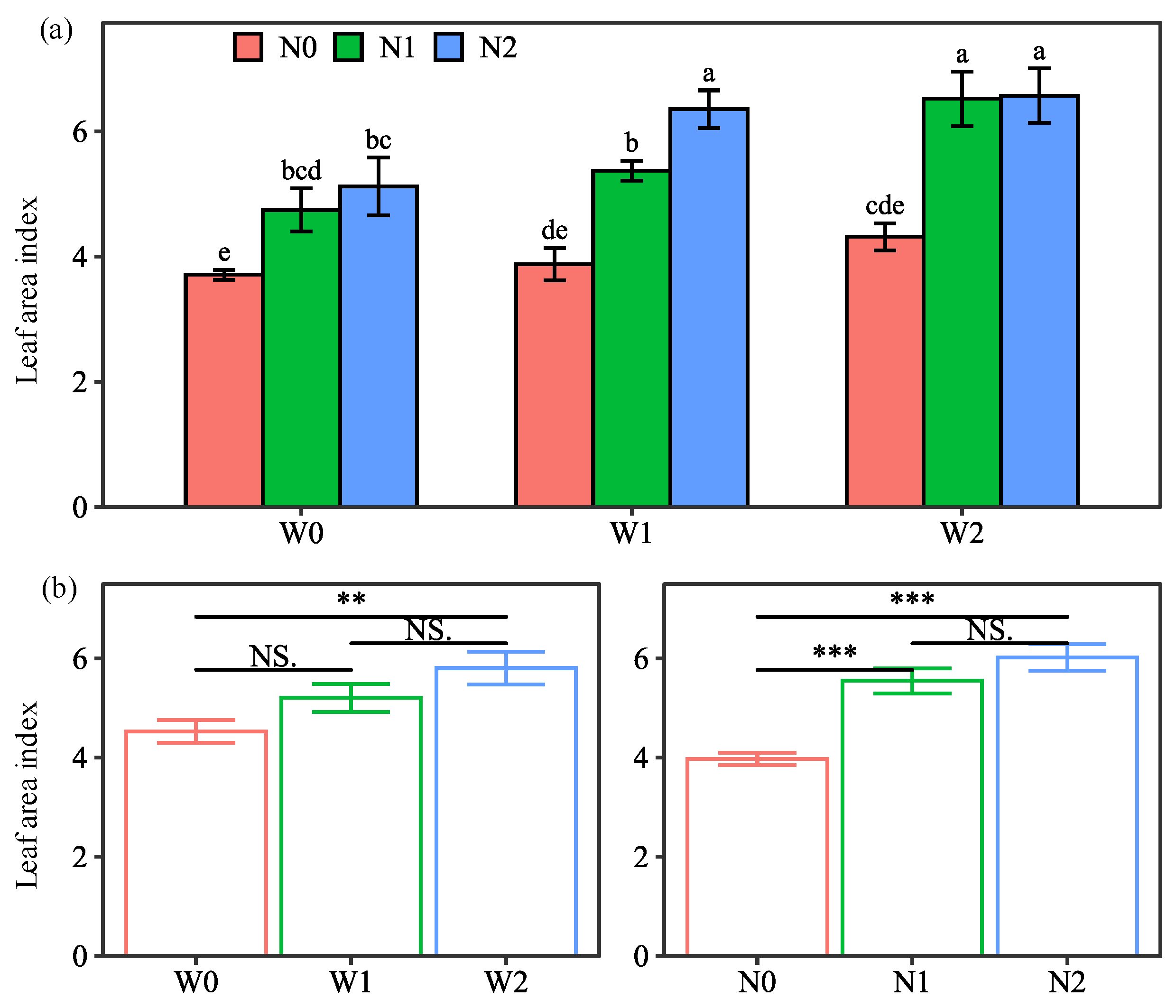
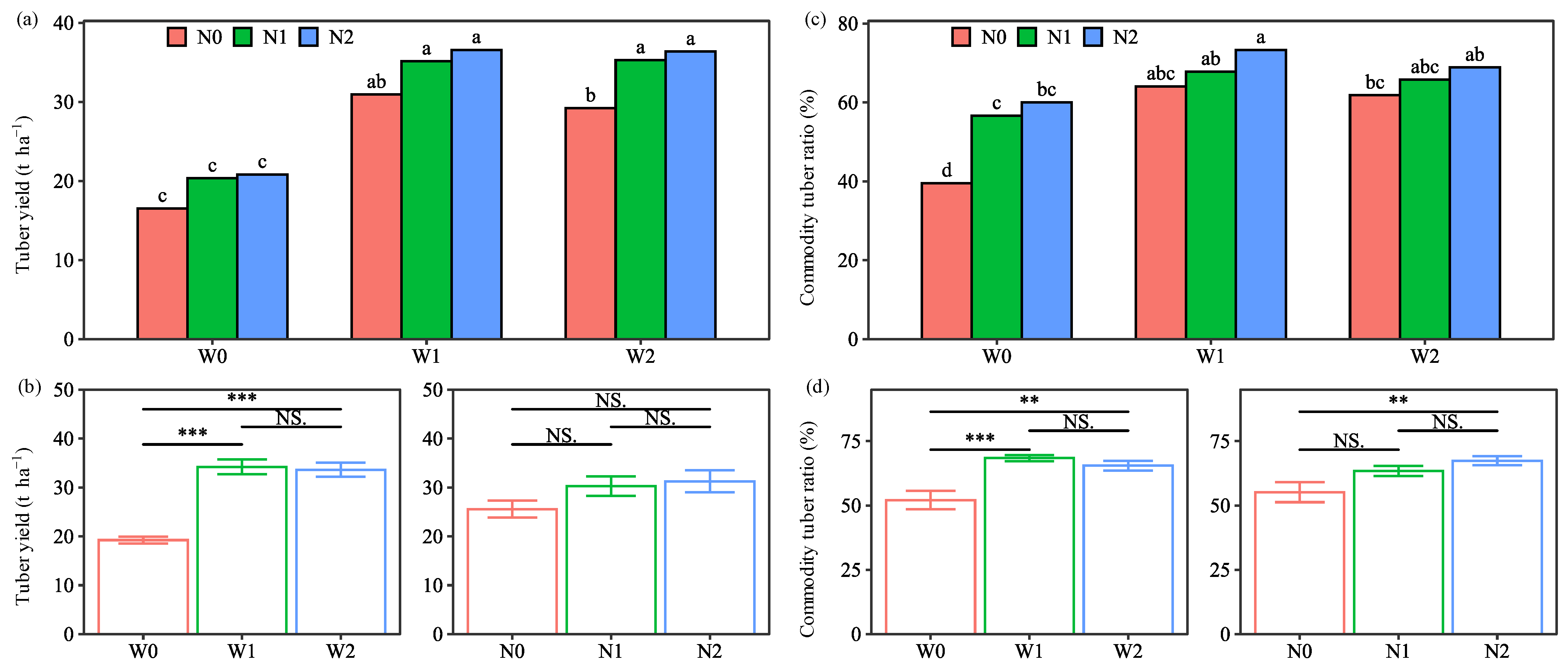


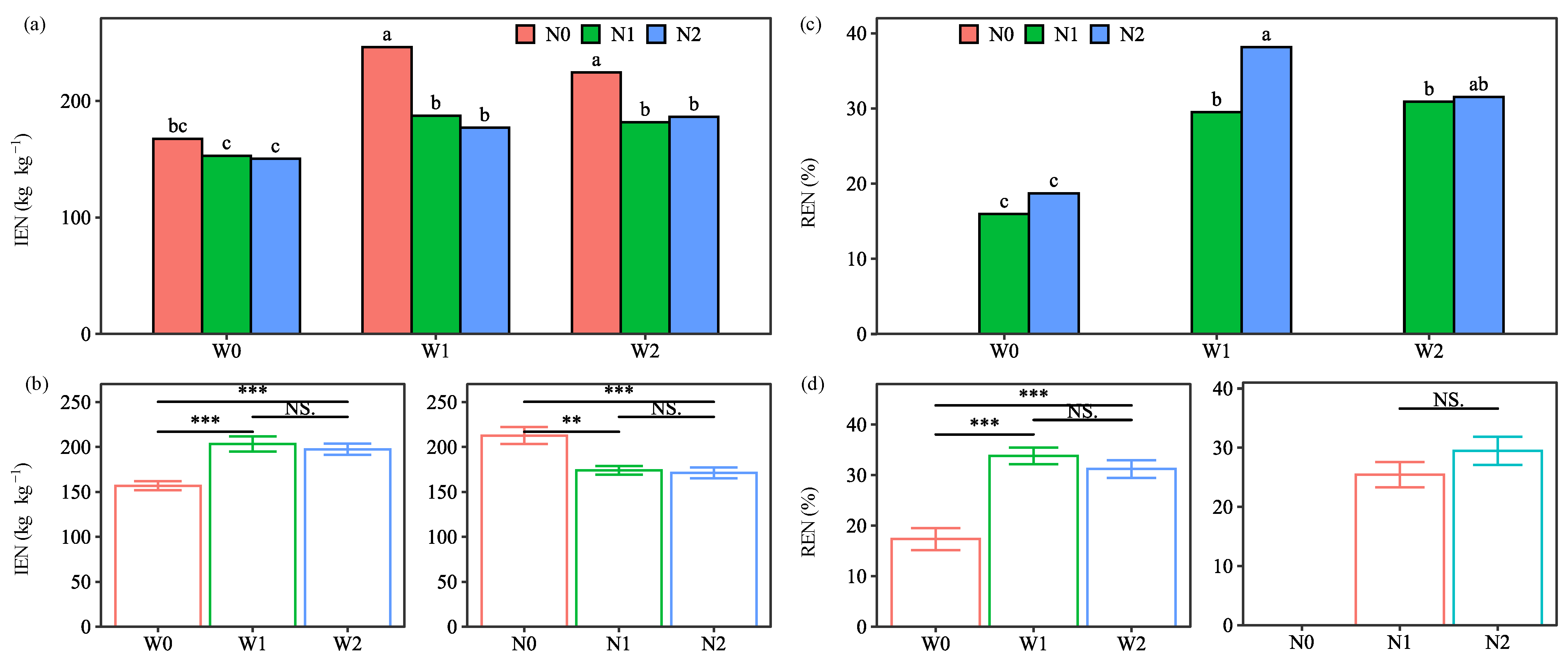
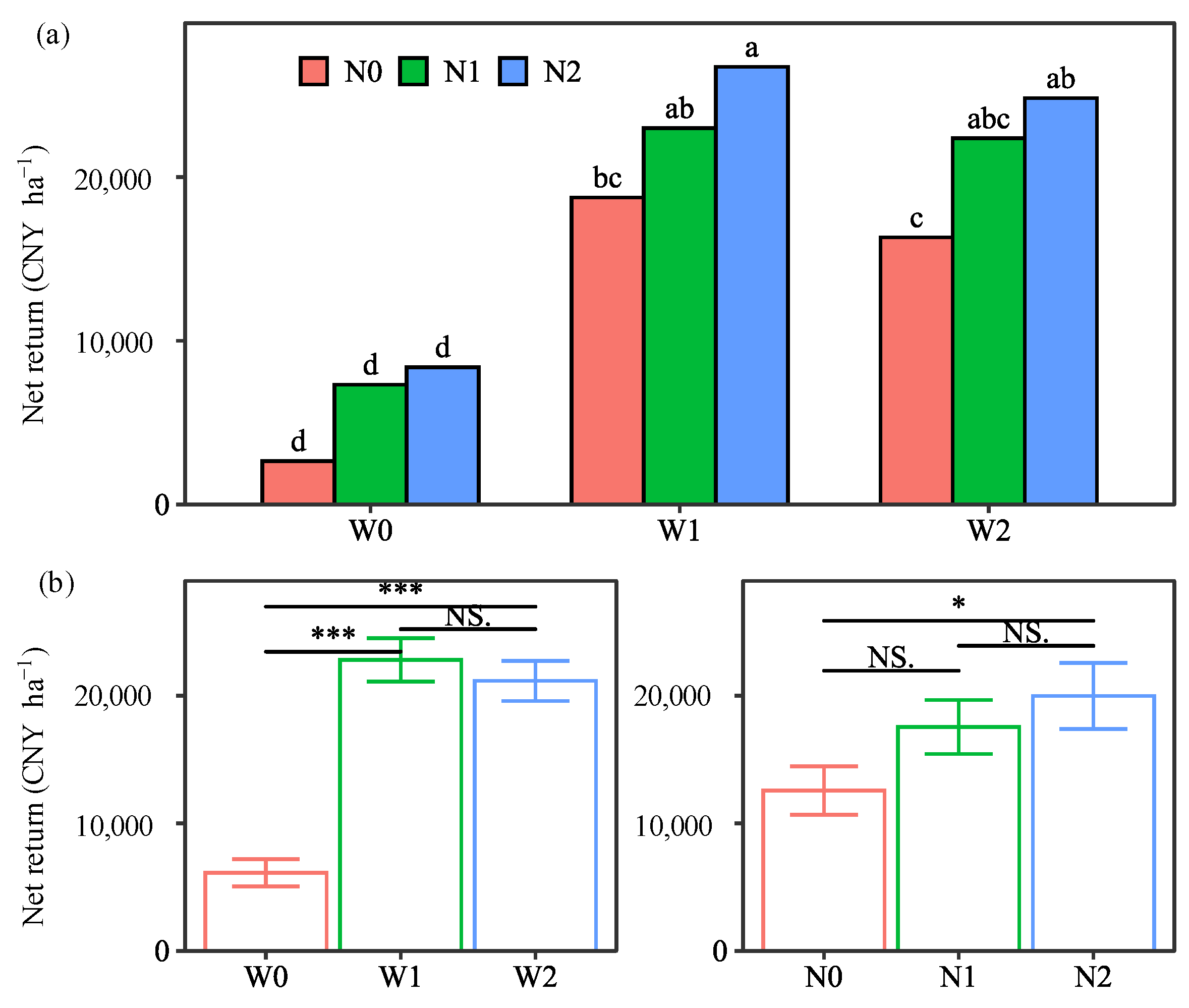
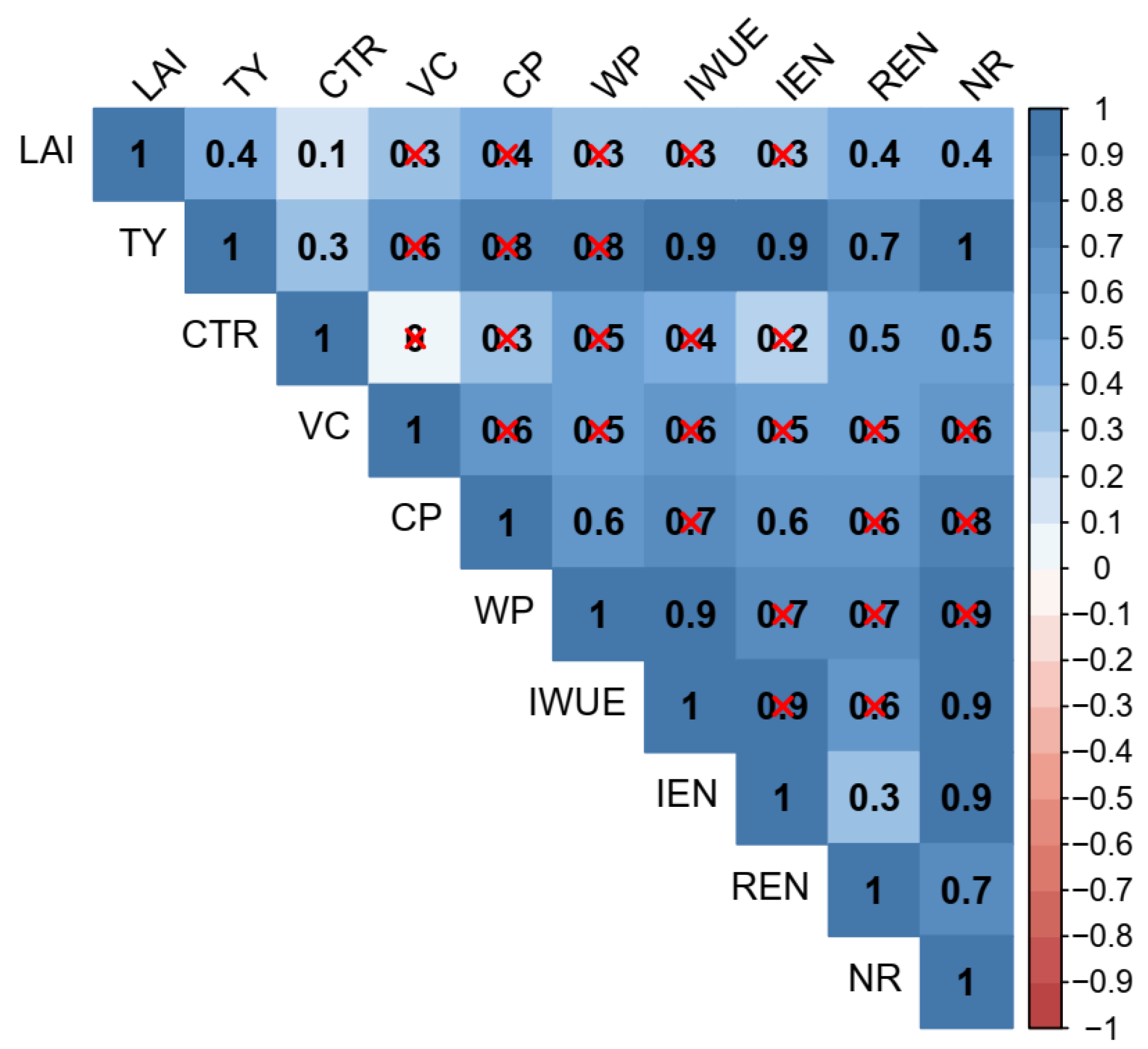
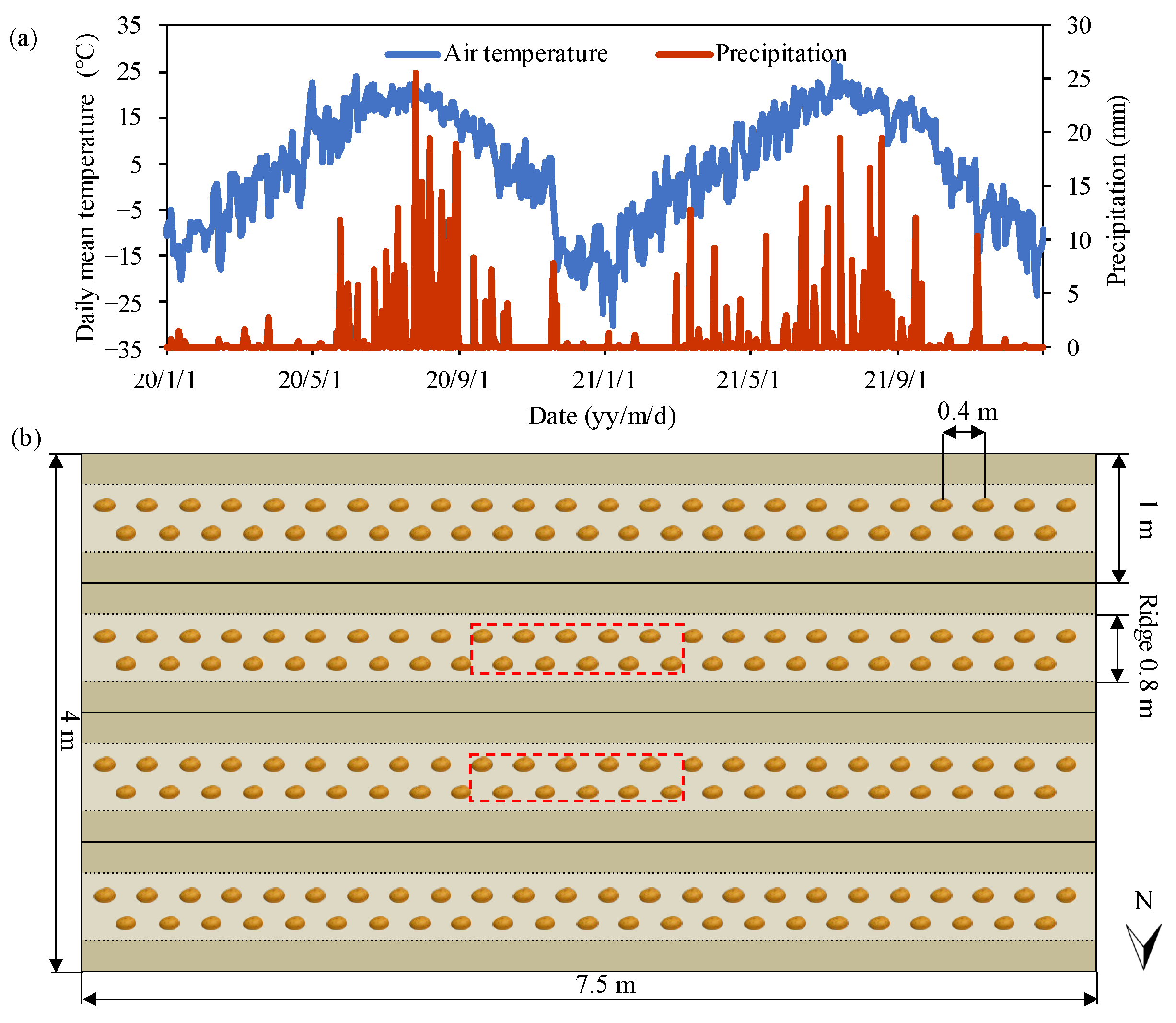
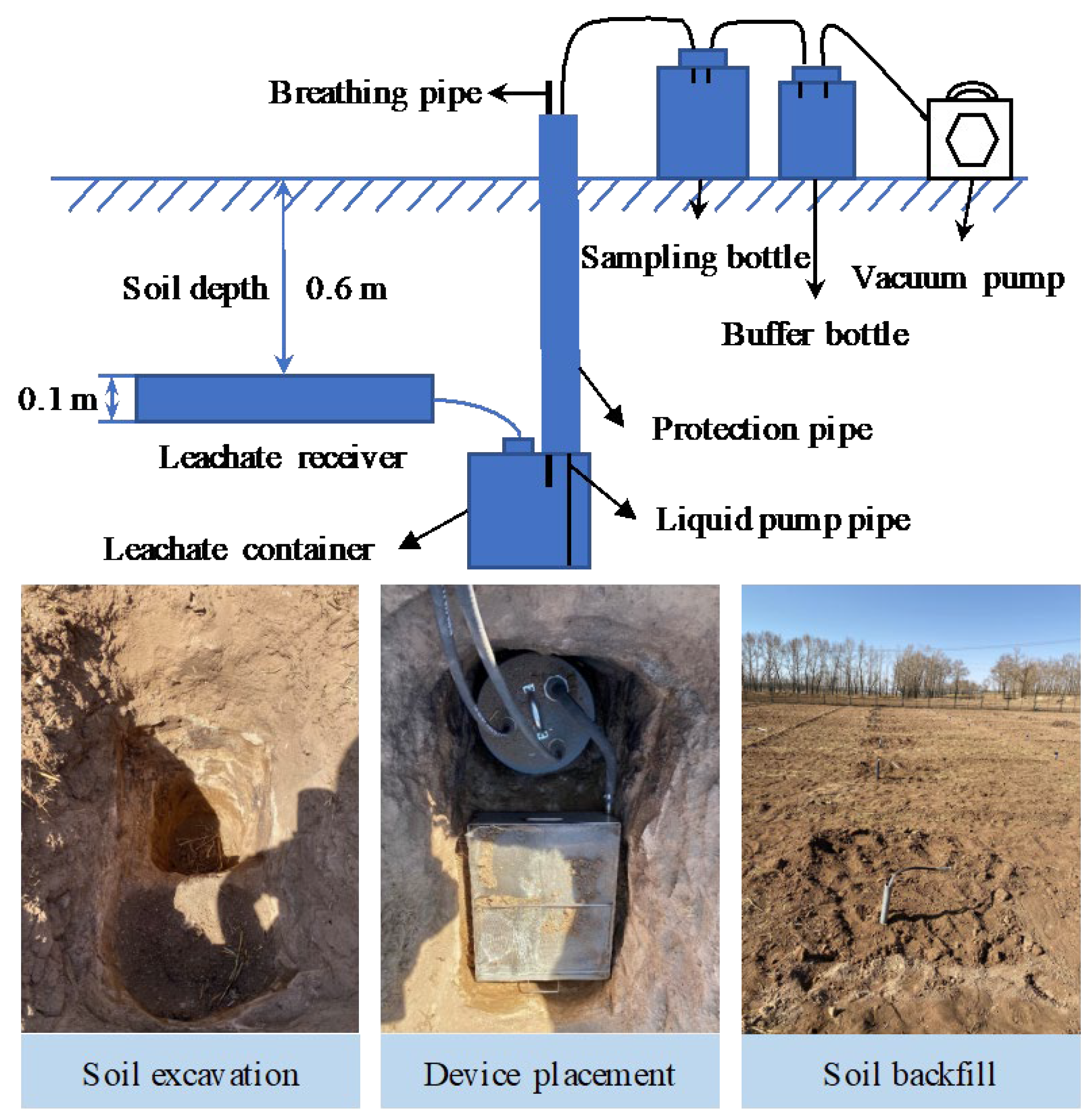

| Index | Water (W) | Nitrogen (N) | Year (Y) | W × N | W × Y | N × Y | W × N × Y | Treatment |
|---|---|---|---|---|---|---|---|---|
| LAI | *** 1 | *** | NS | NS | NS | NS | NS | *** |
| Tuber yield | *** | *** | *** | NS | *** | *** | NS | *** |
| Commodity tuber ratio | *** | *** | *** | ** | *** | *** | NS | *** |
| VC | NS | NS | *** | NS | NS | NS | NS | NS |
| Crude protein | *** | *** | *** | NS | NS | NS | NS | *** |
| WP | *** | *** | ** | NS | *** | NS | NS | *** |
| IWUE | *** | *** | *** | NS | *** | *** | NS | NS |
| IEN | *** | *** | *** | *** | *** | ** | NS | *** |
| REN | *** | ** | NS | NS | *** | NS | NS | *** |
| Net return | *** | *** | *** | NS | *** | *** | NS | *** |
| Treatment 1 | Irrigation Amount (mm) | Chemical Nutrients (kg ha−1) | Manure Nutrients (kg ha−1) | |||||
|---|---|---|---|---|---|---|---|---|
| 2020 | 2021 | N | P2O5 | K2O | N | P2O5 | K2O | |
| W0N0 | 0 | 0 | 0 | 100 | 190 | 0 | 0 | 0 |
| W0N1 | 0 | 0 | 210 | 100 | 190 | 0 | 0 | 0 |
| W0N2 | 0 | 0 | 158 | 90 | 128 | 53 | 10 | 62 |
| W1N0 | 230 | 150 | 0 | 100 | 190 | 0 | 0 | 0 |
| W1N1 | 230 | 150 | 210 | 100 | 190 | 0 | 0 | 0 |
| W1N2 | 230 | 150 | 158 | 90 | 128 | 53 | 10 | 62 |
| W2N0 | 286 | 193 | 0 | 100 | 190 | 0 | 0 | 0 |
| W2N1 | 286 | 193 | 210 | 100 | 190 | 0 | 0 | 0 |
| W2N2 | 286 | 193 | 158 | 90 | 128 | 53 | 10 | 62 |
| Treatment 1 | Comprehensive Evaluation Value | Rank | ||
|---|---|---|---|---|
| TOPSIS | PCA | TOPSIS | PCA | |
| W0N0 | 0.197 | 0.141 | 9 | 9 |
| W0N1 | 0.343 | 0.313 | 8 | 8 |
| W0N2 | 0.356 | 0.350 | 7 | 7 |
| W1N0 | 0.591 | 0.667 | 5 | 5 |
| W1N1 | 0.716 | 0.719 | 4 | 4 |
| W1N2 | 0.782 | 0.753 | 1 | 1 |
| W2N0 | 0.512 | 0.640 | 6 | 6 |
| W2N1 | 0.718 | 0.741 | 3 | 2 |
| W2N2 | 0.769 | 0.737 | 2 | 3 |
| Growth Stage | Lower Limit of SWC | Upper Limit of SWC | Soil Wetted Depth (cm) | Soil Bulk Density (g cm−3) |
|---|---|---|---|---|
| Emergence | 60% FC 1 | 100% FC | 20 | 1.34 |
| Tuberization | 70% FC | 100% FC | 30 | 1.40 |
| Tuber Bulking | 70% FC | 100% FC | 30 | 1.40 |
| Maturation | 60% FC | 80% FC | 30 | 1.40 |
Disclaimer/Publisher’s Note: The statements, opinions and data contained in all publications are solely those of the individual author(s) and contributor(s) and not of MDPI and/or the editor(s). MDPI and/or the editor(s) disclaim responsibility for any injury to people or property resulting from any ideas, methods, instructions or products referred to in the content. |
© 2024 by the authors. Licensee MDPI, Basel, Switzerland. This article is an open access article distributed under the terms and conditions of the Creative Commons Attribution (CC BY) license (https://creativecommons.org/licenses/by/4.0/).
Share and Cite
Jiang, L.; Jiang, R.; He, P.; Xu, X.; Huang, S.; Xie, H.; Wang, X.; Wu, Q.; Zhang, X.; Yang, Y. Synergistic Effects of Soil-Based Irrigation and Manure Substitution for Partial Chemical Fertilizer on Potato Productivity and Profitability in Semiarid Northern China. Plants 2024, 13, 1636. https://doi.org/10.3390/plants13121636
Jiang L, Jiang R, He P, Xu X, Huang S, Xie H, Wang X, Wu Q, Zhang X, Yang Y. Synergistic Effects of Soil-Based Irrigation and Manure Substitution for Partial Chemical Fertilizer on Potato Productivity and Profitability in Semiarid Northern China. Plants. 2024; 13(12):1636. https://doi.org/10.3390/plants13121636
Chicago/Turabian StyleJiang, Lingling, Rong Jiang, Ping He, Xinpeng Xu, Shaohui Huang, Hanyou Xie, Xiya Wang, Qiying Wu, Xia Zhang, and Yi Yang. 2024. "Synergistic Effects of Soil-Based Irrigation and Manure Substitution for Partial Chemical Fertilizer on Potato Productivity and Profitability in Semiarid Northern China" Plants 13, no. 12: 1636. https://doi.org/10.3390/plants13121636
APA StyleJiang, L., Jiang, R., He, P., Xu, X., Huang, S., Xie, H., Wang, X., Wu, Q., Zhang, X., & Yang, Y. (2024). Synergistic Effects of Soil-Based Irrigation and Manure Substitution for Partial Chemical Fertilizer on Potato Productivity and Profitability in Semiarid Northern China. Plants, 13(12), 1636. https://doi.org/10.3390/plants13121636






